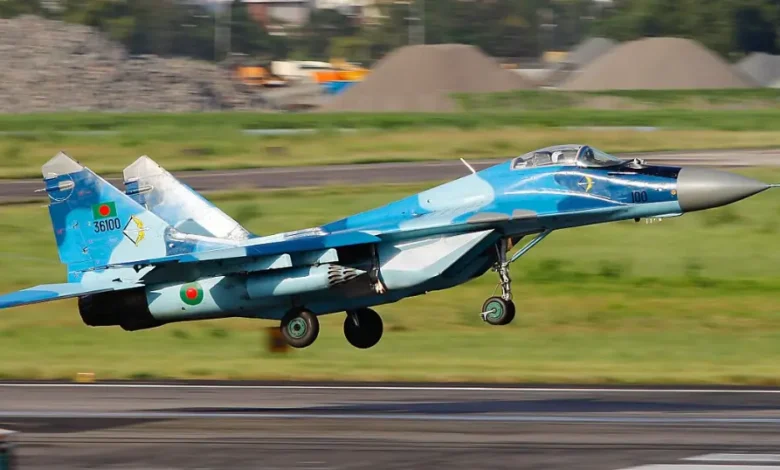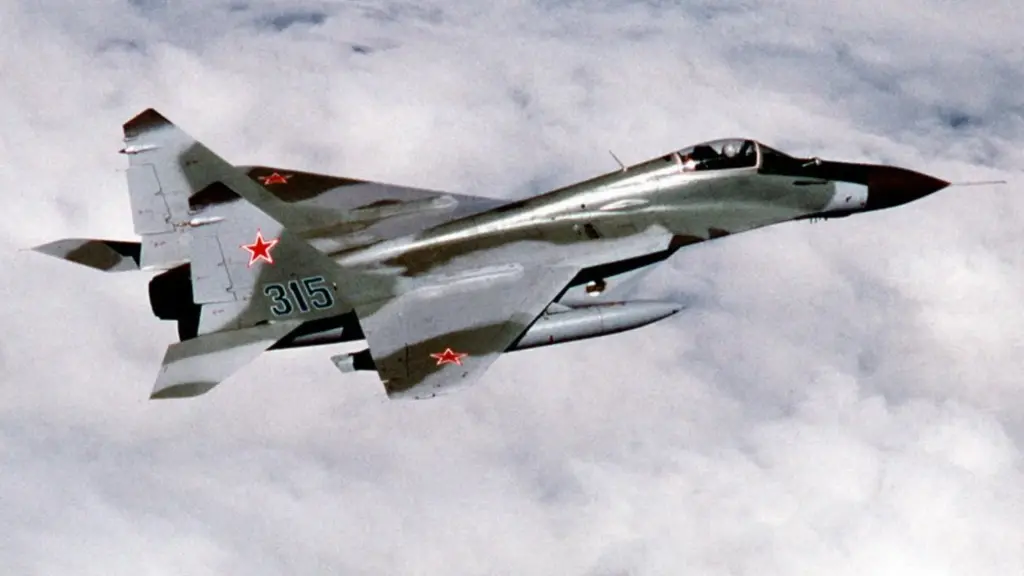Mikoyan MiG-29

The Mikoyan MiG-29, also known as “Fulcrum” by NATO, is a twin-engine, air superiority fighter developed by Mikoyan for the Soviet Air Force. First flown in 1977 and introduced in 1983, the MiG-29 was designed to counter U.S. fourth-generation fighters like the F-15 Eagle and F-16 Fighting Falcon. Known for its agility, advanced aerodynamics, and combat versatility, the MiG-29 remains in service with numerous air forces worldwide.
Fact Sheet
| Role | Air superiority fighter |
|---|---|
| Manufacturer | Mikoyan |
| First Flight | 1977 |
| Service Entry | 1983 |
| Crew | 1 |
Specifications
| Length | 17.32 m (56 ft 10 in) |
|---|---|
| Wingspan | 11.36 m (37 ft 3 in) |
| Height | 4.73 m (15 ft 6 in) |
| Empty Weight | 11,000 kg (24,250 lb) |
| Max Takeoff Weight | 18,000 kg (39,680 lb) |
| Powerplant | 2 × Klimov RD-33 turbofans |
| Thrust | 18,300 lbf (81.3 kN) per engine with afterburner |
| Max Speed | Mach 2.25 (2,400 km/h; 1,490 mph) |
| Service Ceiling | 18,000 m (59,100 ft) |
| Range | 1,430 mi (2,300 km) combat radius |
| Rate of Climb | ~65,000 ft/min (330 m/s) |
Avionics & Armament
| Main Radar | N019 Sapfir-29 radar |
|---|---|
| Avionics | Advanced avionics suite, electronic warfare systems |
| Armament | One 30-mm GSh-30-1 cannon (150 rounds); Up to 6 external hardpoints for: – Air-to-air missiles (R-27, R-73) – Air-to-ground munitions (bombs, rockets) – External fuel tanks |
Notable Features
- Exceptional agility for dogfighting superiority.
- Advanced aerodynamics for high maneuverability.
- Proven combat record in multiple conflicts.
- Widely exported to numerous air forces worldwide.
- Served as the basis for advanced derivatives like the MiG-35.

The Mikoyan MiG-29 (NATO reporting name: Fulcrum) is a twin-engine jet fighter aircraft designed in the Soviet Union during the 1970s. Alongside the larger Sukhoi Su-27, it was developed to counter new U.S. fighters like the F-15 Eagle and F-16 Fighting Falcon. The MiG-29 officially entered service with the Soviet Air Forces in 1982 (some sources say 1983).
While initially conceived primarily as an air superiority fighter, many MiG-29s have since been upgraded to multi-role fighters capable of performing a range of operations, including air-to-surface attack with precision munitions. The MiG-29 has been a popular export aircraft, and over 30 nations either operate or have operated the aircraft to date. As of 2024, Flight Global estimated that around 809 MiG-29s of all types are still in service, making it the 5th most common active fighter globally.
Key Design Features
The MiG-29 is known for several distinctive features that contribute to its performance:
- Twin-Engine Power: It is powered by two widely spaced Klimov RD-33 turbofan engines. This twin-engine configuration provides redundancy and contributes to its high thrust-to-weight ratio, which is excellent for acceleration and climb. The space between the engines also generates lift, improving maneuverability.
- Aerodynamic Design: The MiG-29 features a mid-mounted swept wing with blended leading-edge root extensions (LERXs), swept tailplanes, and two vertical fins mounted outboard of the engines. This design contributes to its exceptional agility, instantaneous and sustained turn performance, and high angle of attack (alpha) capability, making it a potent dogfighter.
- Unique Air Intakes: To protect the engines from foreign object damage (FOD) during operations from rough or unprepared airfields, the engine inlets feature retractable grills for air flow, or on land-based versions, louvers that open on top of the LERXs to allow air in when the main intakes are closed on the ground.
- Basic Avionics (Original Variants): Early MiG-29 models were equipped with the N019 Pulse-Doppler radar, capable of look-down/shoot-down engagements, and an OLS-29 infrared search and track (IRST) system for passive target detection.
- Helmet-Mounted Targeting System (HMS): A significant innovation for its time, the MiG-29 was one of the first fighters to integrate a helmet-mounted sight, allowing pilots to “look” at a target and cue their short-range missiles (like the R-73) off-boresight, enhancing close-combat effectiveness.
- Armament: The MiG-29 is armed with an internal 30mm GSh-30-1 cannon in the port wing root. It has up to 7 hardpoints (6 underwing, 1 under fuselage) to carry a variety of air-to-air missiles (R-60, R-73, R-27, R-77 on later variants) and, increasingly on modernized versions, air-to-surface munitions (bombs, rockets, and various missiles).
Variants and Modernizations
The MiG-29 family has seen extensive development, with numerous variants tailored for different roles and customers:
- MiG-29A (Fulcrum-A): The initial production single-seat air superiority fighter.
- MiG-29UB (Fulcrum-B): A two-seat combat-capable trainer variant.
- MiG-29S (Fulcrum-C): Improved variants with slightly increased fuel capacity (dorsal hump) and the ability to carry longer-range R-27E missiles.
- MiG-29M (Fulcrum-E): A significantly upgraded multi-role variant with fly-by-wire controls, improved engines (RD-33MK), larger fuel capacity, and an enhanced multi-function radar. This variant was developed in the late Soviet era but saw limited production.
- MiG-29K (Fulcrum-D): A navalized, carrier-based multi-role variant (derived from the MiG-29M) with reinforced landing gear, folding wings, an arrestor hook, and increased internal fuel. This is the primary fixed-wing fighter for the Russian Navy’s aircraft carrier and is also operated by the Indian Navy.
- MiG-29SMT (Fulcrum-F): A major modernization package for existing MiG-29s, featuring a larger dorsal fuel tank, “glass cockpit” with multi-function displays, upgraded N010 Zhuk-M radar, and multi-role capabilities.
- MiG-35 (Fulcrum-F): The latest and most advanced derivative, considered a “4++ generation” fighter. It incorporates AESA radar (Zhuk-AE), thrust-vectoring engines (optional), advanced OLS-35 IRST, and vastly improved avionics and weapon systems.
Operators
The MiG-29 has been widely exported, with many countries continuing to operate and modernize their fleets. Major operators include:
- Russia: Operates MiG-29SMT, MiG-29K, and some older variants.
- India: Operates a large fleet of MiG-29UPG (upgraded) for its air force and MiG-29K/KUB for its navy.
- Ukraine: Inherited a large number from the Soviet Union and has used them extensively in the ongoing conflict.
- Algeria: Operates MiG-29S and newer MiG-29M/M2.
- Poland: One of the few NATO members still operating the MiG-29 (though these are being phased out as F-16s and F-35s arrive, with some already transferred to Ukraine).
- Bulgaria: Also a NATO operator, transitioning to F-16s.
- Serbia: Operates modernized MiG-29s.
- Bangladesh
- Cuba
- Eritrea
- Iran
- Kazakhstan
- Myanmar
- North Korea
- Peru
- Sudan
- Syria
- Uzbekistan
- Yemen
Combat Record
The MiG-29 has seen extensive combat in various conflicts around the world, with mixed results often depending on the specific variant, pilot training, and the opposing forces’ capabilities and support systems (like AWACS):
- Gulf War (1991): Iraqi MiG-29s faced coalition forces, primarily F-15s. While some MiG-29s were shot down, most engagements were brief and often one-sided due to the technological superiority and air supremacy of coalition forces, particularly with AWACS support.
- Eritrean-Ethiopian War (1998-2000): MiG-29s of Eritrea and Su-27s of Ethiopia engaged in air-to-air combat. Ethiopian Su-27s reportedly shot down several Eritrean MiG-29s.
- Kosovo War (1999): Serbian MiG-29s engaged NATO aircraft. Several were shot down by F-15s and F-16s, again highlighting the challenges faced by older generation aircraft without modern support systems against a technologically superior adversary.
- Kargil War (1999): Indian Air Force MiG-29s provided combat air patrol and escort duties for strike aircraft during the conflict with Pakistan.
- Syrian Civil War: Syrian Air Force MiG-29s have been involved, though their specific combat performance has been difficult to ascertain.
- Russo-Ukrainian War (2022-Present): Ukrainian Air Force MiG-29s have played a crucial role in air defense, often engaging Russian aircraft and cruise missiles. Despite being older models and facing a numerically superior and often technologically more advanced Russian air force, Ukrainian pilots have demonstrated remarkable skill and resilience. Russia has also used its own modernized MiG-29s in the conflict.
The Mikoyan MiG-29, despite its age for early variants, remains a widely used and recognizable fighter. Its continuous modernization, exemplified by the MiG-29M, MiG-29K, and especially the MiG-35, ensures its continued relevance as a formidable and relatively affordable multi-role aircraft on the global stage.



